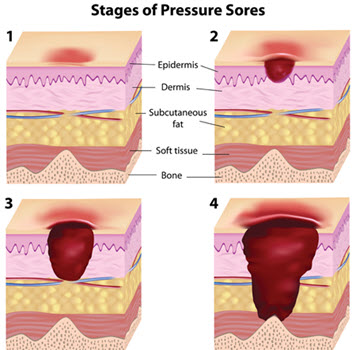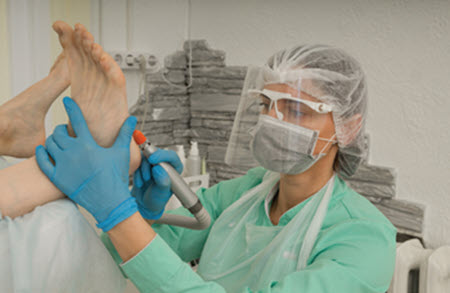Can You Code This Pressure Ulcer Case Study?
Be sure to pay attention to ICD-10-CM guidelines and debridement descriptors. A patient reports to your podiatrist with a pressure ulcer of the right heel. The podiatrist notes there is tissue loss that goes down to the bone; the wound is necrotic, and the notes indicate it has begun to develop gangrene. The podiatrist cleans and debrides the wound, bandages it, and gives the patient instructions to keep the wound clean and bandaged and to report back in two weeks. What diagnosis codes would you use to document this encounter? Do you know the ICD-10-CM guidelines and CPT® descriptors that will inform your code choice? Read on, and test your knowledge of this scenario commonly seen in podiatry practices. Code First for Associated Gangrene Before you dig into the L89.- (Pressure ulcer) codes, you will need to pay attention to the Code first note that accompanies the group. There, you’ll find the instruction to sequence I96 (Gangrene, not elsewhere classified) before documenting the specified pressure ulcer. Code for the Pressure Ulcer As pressure ulcer codes are broken down first by site, determining the first four characters of the diagnosis code is relatively straightforward. The podiatrist’s notes indicate the pressure ulcer is on the patient’s heel, so you’ll look to the L89.6- (Pressure ulcer of heel) codes to begin narrowing down your code options. Coding caution 1: If your podiatrist has documented a specific site on the patient’s foot that is neither the heel nor the ankle, which is coded to L89.5 (Pressure ulcer of ankle), you may have to reach for L89.89- (Pressure ulcer of other site). That’s because “‘Other site’ means that the provider has indicated where the ulcer is, but there is no specific code under L89.- that specifies the site documented,” according to Melanie Witt, RN, CPC, MA, an independent coding expert based in Guadalupita, New Mexico. This is not to be confused with L89.9- (Pressure ulcer of unspecified site), which “would mean that the provider has not documented where the ulcer is at all,” Witt notes. Next, you’ll add a 5th character to specify laterality — in this case, L89.62 (Pressure ulcer of left heel). Coding Caution 2: The L89 codes are broken down by right, left, and unspecified anatomic areas of most sites. There are no bilateral codes, however, which means pressure ulcers equally affecting both sides of an anatomic region have to be coded separately using the codes for right and left. Then, things can get a little tricky, as you will need to determine the 6th character of the code to document the severity of the ulcer. Your character choices are: In our scenario, again, your choice is made easy by good provider documentation. As the tissue loss goes to the bone, and the wound has become necrotic, you are dealing with a stage 4 ulcer. So, you would apply 6th character 4, giving you L89.624 (Pressure ulcer of left heel, stage 4). Coding caution 3: In coding the ulcer’s severity, you can again be confused by staging classifications “unspecified” and “unstageable.” Here, you’ll need to follow ICD-10-CM guideline I.C.12.b, which tells you unstageable means that the depth, or stage, of the wound cannot be determined as slough and/or eschar are covering the wound bed. As both enable the wound to heal, your provider may not remove them to determine the stage, so the stage is classified unstageable. However, “coding a pressure ulcer as unstageable is a rare occurrence,” according to Marcella Bucknam, CPC, CCS-P, COC, CCS, CPC-P, CPC-I, CCC, COBGC, revenue cycle analyst with Klickitat Valley Health in Goldendale, Washington. Coding caution 4: Documentation of pressure ulcer stages by “clinicians who are not the patient’s provider (i.e., physician or other qualified healthcare practitioner legally accountable for establishing the patient’s diagnosis)” is allowable under ICD-10-CM guideline I.B.14. However, even though nurse documentation “can be used to code the stage at this encounter, it is the provider who is attending the patient at this visit who is responsible for assigning the severity of the ulcer,” Witt points out. Again, this conforms to guideline I.B.14, which states the pressure ulcer “must be documented by the patient’s provider,” and “if there is conflicting medical record documentation … the patient’s attending provider should be queried for clarification.” In other words, even though “pressure ulcer details, like staging, are often documented by nurses, coders should only use documentation provided by the physician,” Bucknam notes. Go above and beyond: For more details about the National Pressure Ulcer Staging System, go to https://www.ncbi.nlm.nih. gov/books/NBK2650/pdf/Bookshelf_NBK2650.pdf. Code for the Debridement In this case, you’ll choose 11044 (Debridement, bone (includes epidermis, dermis, subcutaneous tissue, muscle and/or fascia, if performed); first 20 sq cm or less), if wound is less than 20 sq cm, adding +11047 (… each additional 20 sq cm, or part thereof (List separately in addition to code for primary procedure)) if the wound is larger. You’ll choose one of these codes over the other debridement codes such as 11042/+11045 (Debridement, subcutaneous tissue …) or 11043/+11046 (Debridement, muscle and/or fascia …) as “wound-debridement codes 11044-+11047 all involve deeper layers,” says Bucknam. You’ll also choose 11044/+11047 over 97597/+97598 (Debridement … for ongoing care …) or even 97602 (Removal of devitalized tissue from wound(s) … for ongoing care …), as the descriptors tell you these codes are not for an initial wound debridement encounter but for subsequent active wound care management. Remember: “It is important to understand the purpose and intent of each set of debridement codes. Codes 11042-+11047 are reported by depth and not by location. You can report one code per depth, so if multiple wounds are debrided, you only report one code regardless if they are the same depth because you will report these as a combined square centimeter calculation. Practices are seeing denials due to overbilling of the codes at the same depth,” cautions Jennifer McNamara CPC, CCS, CPMA, CRC, CGSC, COPC, AAPC Approved Instructor, director of education and coding at OncoSpark in Southpark, Texas.





